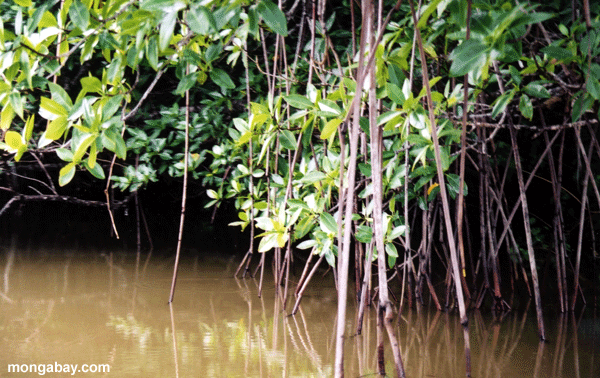|
|
|
|

|
Environmental Degradation from Shrimp Farming
According to a new report by The Environmental Justice Foundation, growing consumer demand for shrimp is fueling an environmental crisis. Shrimp farming is destroying biologically rich mangrove forests and estuaries, causing pollution, and depleting wild fish stocks.
Shrimp Farming Overview
Shrimp farming is a lucrative business and according to The Environmental Justice Foundation (as reported by the BBC), "export-orientated shrimp aquaculture has been promoted by aid agencies, financial organizations and governments as a path for developing countries to reach development targets and alleviate poverty." For example, in 2000, the leading shrimp-producing countries were Thailand, China, Indonesia, India, Vietnam, Ecuador, the Philippines, Bangladesh, Mexico and Brazil.
While laws have been passed to regulate shrimp farm development, authorities are often hesitant to enforce regulations due to the income it brings the local population. In many areas shrimp provide the highest immediate return for poor farmers and fisherman.
Shrimp farming is common in some parts of the tropics where farms generally can produce two to three crops per year. Typically, a farmer will create an impoundments ranging in size from a couple hectares to over a hundred hectares along tidal rivers or estuaries. The pools will be stocked with either wild shrimp larvae (captured from surrounding waters) or shrimp larvae from hatcheries elsewhere. Juvenile shrimp feed on naturally occurring plankton and microorganisms (the growth of which may be encouraged with organic or chemical fertilizers) and are kept in growout ponds until they reach marketable size. For more information on the shrimp farming process, Shrimp News International has an excellent in-depth explanation complete with diagrams and tables.
Mangrove destruction
Mangrove forest is found in silt-rich, saline (brackish water) habitats worldwide, generally along large river deltas, estuaries, and coastal areas. It is characterized by low tree diversity, almost exclusively mangroves, with a low broken canopy. Mangroves are evergreen trees and shrubs that are well adapted to their salty and swampy habitat by having breathing roots (pneumatophores) that emerge from the oxygen-deficient mud to absorb oxygen.
Their location combined with their low perceived value makes mangrove forests prime targets for shrimp farm development. Ironically this form of aquaculture comes at the expense of the natural fish and shrimp hatchery since mangroves are critical spawning/nursery grounds for many commercially important species. Additionally, mangrove forests protect coastal regions against storm damage and erosion.
Today, mangrove forests are rapidly disappearing (at rates exceeding those of tropical rainforests) due to farming, harvesting for timber and charcoal, freshwater diversion, and conversion for tourism. The Environmental Justice Foundation estimates that as much as 38% of global mangrove deforestation is linked to shrimp farm development.
Pollution
As mentioned above, shrimp feed on naturally occurring plankton and microorganisms which can be encouraged to grow by adding antibiotics and organic and chemical fertilizers to shrimp ponds. Pollution from ponds is flushed into the surrounding ecosystem by tides. The release of antibiotics into natural systems increases resistance among bateria and threatens human and livestock populations with infection.
Shrimp farms are also known to sometimes increase the salinity of surrounding farmland and alter the water chemistry of aquatic ecosystems.
Loss of Biodiversity
Biodiversity is impacted in several ways by shrimp aquaculture, including:
- the loss of important spawning and nursey grounds affects local fisheries resulting in reduced yields for local fishermen. Many coral reef species spend a portion of their lifecycle in mangrove forests.
- the practice of catching post-larva shrimp results in losses of other species as bycatch
- the use of imported post-larvae shrimps from other countries to to seed production ponds can result in the introduction of alien.
What can be done
Addressing the environmental impacts of shrimp farming is a tremendous challenge. Already a number of countries have passed laws that protect mangrove habitats and restrict the development of shrimp farms, but enforcement is difficult in practice. Shrimp are simply the most viable economic option for coastal communities in many areas. How can conservation of wildlands be balanced with the needs of locals?
Perhaps the best approach is addresing the consumption side -- though growing demand makes this an uphill battle. Educating consumers in developed countries to avoid shrimp could help slow demand and force producing countries to look at the sustainabilty of current methods of shrimp farming. Funding for programs that encourage sustainable economic development for coastal communities can also help.
Using our intelligence and ingenuity, the human species can preserve biodiversity and unique places for future generations, without compromising the quality of life for present populations.
More:
Central Amreican Estuary Description
Mangrove forests
Mangrove forest pictures (Honduras)
News articles on mangrove forests
|
|